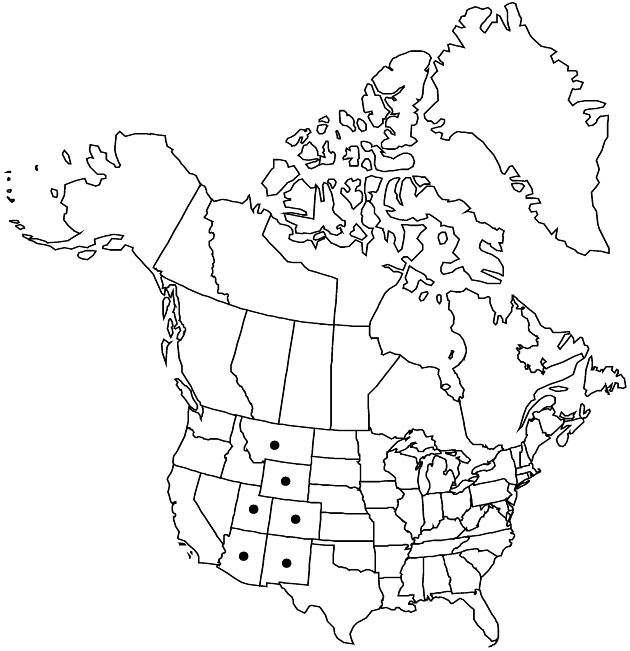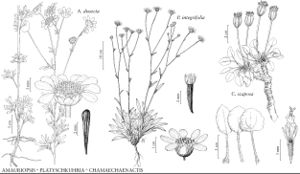Difference between revisions of "Platyschkuhria integrifolia"
Bull. Torrey Bot Club 33: 155. 1906.
FNA>Volume Importer |
FNA>Volume Importer |
||
| Line 10: | Line 10: | ||
|name=Schkuhria integrifolia | |name=Schkuhria integrifolia | ||
|authority=A. Gray | |authority=A. Gray | ||
| − | }}{{Treatment/ID/Synonym | + | }} {{Treatment/ID/Synonym |
|name=Bahia nudicaulis | |name=Bahia nudicaulis | ||
|authority=A. Gray | |authority=A. Gray | ||
| Line 17: | Line 17: | ||
|name=Bahia nudicaulis var. desertorum | |name=Bahia nudicaulis var. desertorum | ||
|authority=(M. E. Jones) Cronquist | |authority=(M. E. Jones) Cronquist | ||
| − | }}{{Treatment/ID/Synonym | + | }} {{Treatment/ID/Synonym |
|name=Bahia nudicaulis var. oblongifolia | |name=Bahia nudicaulis var. oblongifolia | ||
|authority=(A. Gray) Cronquist | |authority=(A. Gray) Cronquist | ||
| − | }}{{Treatment/ID/Synonym | + | }} {{Treatment/ID/Synonym |
|name=Bahia nudicaulis var. ourolepis | |name=Bahia nudicaulis var. ourolepis | ||
|authority=(S. F. Blake) Cronquist | |authority=(S. F. Blake) Cronquist | ||
| − | }}{{Treatment/ID/Synonym | + | }} {{Treatment/ID/Synonym |
|name=Platyschkuhria integrifolia var. desertorum | |name=Platyschkuhria integrifolia var. desertorum | ||
|authority=(M. E. Jones) W. L. Ellison | |authority=(M. E. Jones) W. L. Ellison | ||
| − | }}{{Treatment/ID/Synonym | + | }} {{Treatment/ID/Synonym |
|name=Platyschkuhria integrifolia var. oblongifolia | |name=Platyschkuhria integrifolia var. oblongifolia | ||
|authority=(A. Gray) W. L. Ellison | |authority=(A. Gray) W. L. Ellison | ||
| − | }}{{Treatment/ID/Synonym | + | }} {{Treatment/ID/Synonym |
|name=Platyschkuhria integrifolia var. ourolepis | |name=Platyschkuhria integrifolia var. ourolepis | ||
|authority=(S. F. Blake) W. L. Ellison | |authority=(S. F. Blake) W. L. Ellison | ||
| Line 47: | Line 47: | ||
|elevation=1100–2200 m | |elevation=1100–2200 m | ||
|distribution=Ariz.;Colo.;Mont.;N.Mex.;Utah;Wyo. | |distribution=Ariz.;Colo.;Mont.;N.Mex.;Utah;Wyo. | ||
| − | |discussion=<p>Specimens of Platyschkuhria integrifolia with stems leafy over 3/4+ of their lengths have been called var. oblongifolia (mostly from “four-corners” area of Arizona, Colorado, New Mexico, and Utah). Those with leaves mostly on proximal 1/10–3/4 their stem lengths, peduncles little or not at all stipitate-glandular, and phyllary tips ± caudate have been called var. ourolepis (mostly from Uinta Basin, Utah). Those with leaves mostly on proximal 1/10–3/4 their stem lengths, leaf blades widest beyond their middles and rounded at tips, peduncles ± stipitate-glandular, and phyllary tips acute to acuminate have been called var. nudicaulis (mostly from Montana and Wyoming). Those with leaves mostly on proximal 1/10–3/4 their stem lengths, leaf blades widest proximal to their middles and acute at tips, peduncles ± stipitate-glandular, and phyllary tips obtuse to acute or acuminate have been called var. desertorum (mostly from western Colorado and eastern Utah).</p> | + | |discussion=<p>Specimens of <i>Platyschkuhria integrifolia</i> with stems leafy over 3/4+ of their lengths have been called <i></i>var.<i> oblongifolia</i> (mostly from “four-corners” area of Arizona, Colorado, New Mexico, and Utah). Those with leaves mostly on proximal 1/10–3/4 their stem lengths, peduncles little or not at all stipitate-glandular, and phyllary tips ± caudate have been called var. ourolepis (mostly from Uinta Basin, Utah). Those with leaves mostly on proximal 1/10–3/4 their stem lengths, leaf blades widest beyond their middles and rounded at tips, peduncles ± stipitate-glandular, and phyllary tips acute to acuminate have been called var. nudicaulis (mostly from Montana and Wyoming). Those with leaves mostly on proximal 1/10–3/4 their stem lengths, leaf blades widest proximal to their middles and acute at tips, peduncles ± stipitate-glandular, and phyllary tips obtuse to acute or acuminate have been called var. desertorum (mostly from western Colorado and eastern Utah).</p> |
|tables= | |tables= | ||
|references= | |references= | ||
| Line 71: | Line 71: | ||
|publication year=1906 | |publication year=1906 | ||
|special status= | |special status= | ||
| − | |source xml=https://jpend@bitbucket.org/aafc-mbb/fna-data-curation.git/src/ | + | |source xml=https://jpend@bitbucket.org/aafc-mbb/fna-data-curation.git/src/8f726806613d60c220dc4493de13607dd3150896/coarse_grained_fna_xml/V19-20-21/V21_992.xml |
|tribe=Asteraceae tribe Heliantheae | |tribe=Asteraceae tribe Heliantheae | ||
|subtribe=Asteraceae (tribe Heliantheae) subtribe Chaenactidinae | |subtribe=Asteraceae (tribe Heliantheae) subtribe Chaenactidinae | ||
Revision as of 15:38, 18 September 2019
Leaf blades 2–10 cm × 5–35+ mm. Involucres 9–12+ × 12–25+ mm. Ray corolla laminae 6–16 mm. Disc corollas 3–6(–7) mm. Cypselae (1–)3–5(–8) mm; pappi 0.6–3+ mm. 2n = 24, 48, 60, 72.
Phenology: Flowering May–Jul.
Habitat: Seleniferous clays, shaley slopes
Elevation: 1100–2200 m
Distribution

Ariz., Colo., Mont., N.Mex., Utah, Wyo.
Discussion
Specimens of Platyschkuhria integrifolia with stems leafy over 3/4+ of their lengths have been called var. oblongifolia (mostly from “four-corners” area of Arizona, Colorado, New Mexico, and Utah). Those with leaves mostly on proximal 1/10–3/4 their stem lengths, peduncles little or not at all stipitate-glandular, and phyllary tips ± caudate have been called var. ourolepis (mostly from Uinta Basin, Utah). Those with leaves mostly on proximal 1/10–3/4 their stem lengths, leaf blades widest beyond their middles and rounded at tips, peduncles ± stipitate-glandular, and phyllary tips acute to acuminate have been called var. nudicaulis (mostly from Montana and Wyoming). Those with leaves mostly on proximal 1/10–3/4 their stem lengths, leaf blades widest proximal to their middles and acute at tips, peduncles ± stipitate-glandular, and phyllary tips obtuse to acute or acuminate have been called var. desertorum (mostly from western Colorado and eastern Utah).
Selected References
None.
